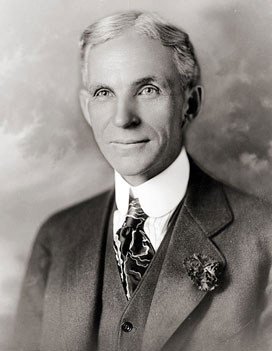
Source: Henry Ford in 1919, Hazhk, Wikimedia

Source: Henry Ford in 1919, Hazhk, Wikimedia
The American Industrial Revolution of the late 1800s forever transformed the way that Americans worked. In the United States, the Industrial Revolution impacted many aspects of the business. During this period, the United States moved from an agricultural economy to one that was based on the mass production goods.
Factories began to pop up in many major cities across the United States. The increase in factories increased manufacturing output while decreasing the cost of production. Many of the factory owners employed different methods of work to increase a faster and cheaper output of goods. The implementation of the assembly line is one of the methods of work that was vital to this success.
By the 1900s, one factory owner managed to revolutionize the assembly line and make it one of the most effective methods of work in America. Henry Ford, an automobile manufacturer, implemented the assembly line in his Michigan plant in 1910. Ford’s assembly line consisted of conveyer belts that brought parts to the worker, and divided the work amongst the employees.
![]() Watch the video below to learn more about Henry Ford’s work.
Watch the video below to learn more about Henry Ford’s work.
Source: Model T Ford-100 Year Later, Car Data Video, YouTube
Ford’s assembly quickly increased production while reducing the time it took to manufacture an automobile. Ford’s productivity forced many of the smaller automobile manufacturers to close their doors.
Ford inspired more companies to use the assembly line throughout U.S. history. The more modern use of the assembly line includes computer mechanisms and additional sub-assembly lines to increase production.
![]() The Assembly Line: Then and Now
The Assembly Line: Then and Now
Quick Reflection - How did Ford’s assembly line impact the worker? How does today’s assembly line combat this issue?

Another work method that has been added to modern assembly lines is the just-in-time systems (JIT), which adds to the efficiency in the workplace. The goal of JIT is to make only what is needed. Read below to learn more about JIT.
Today’s assembly lines are constantly being monitored and improved upon. Managers are always on the lookout for things that waste time and motion, and they determine ways to change it. A drawback to assembly line production is the physical ailments caused by workers doing repetitive work.
Toyota currently uses the just-in-time system in their assembly line. Click on the links below to learn more.
Just-in-Time — Philosophy of complete elimination of waste
Illustration of the Toyota Production System
The technological innovations throughout U.S. history have historically impacted the economic development of the nation. Communication and transportation are crucial systems of the nation’s infrastructure. Over time, each of these systems has contributed to the progress of the American economy. Advances in the agricultural industry have allowed this industry to last throughout every era of U.S. history. Science and space innovation in the United States helped the United States become a global leader in space exploration and scientific discoveries.